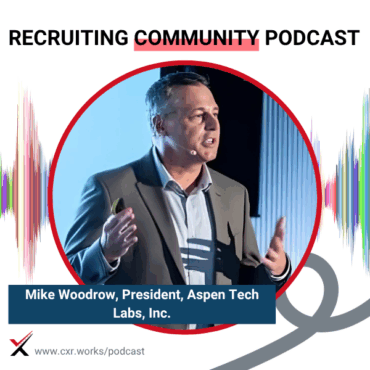
Real-Time Jobs Data and the TA Advantage
What happens when real-time job data meets TA strategy? Michael Woodrow explains how clean data fuels smarter hiring decisions across the globe.
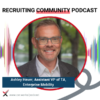 play_arrow
play_arrow
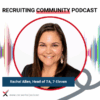 play_arrow
play_arrow
Transforming High-Volume Hiring at 7-Eleven Cami Grace
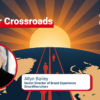 play_arrow
play_arrow
From Early Childhood to Talent Tech: Allyn Bailey’s Career Crossroads Cami Grace
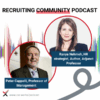 play_arrow
play_arrow
In Praise of the Office Cami Grace

Featured Guests:
Chris Hoyt, CareerXroads
Gerry Crispin, CareerXroads
Cathy Henesey, VP of Extended Workforce, AdventHealth
Hosts:
Johnny Campbell, CEO, SocialTalent
Episode Overview:
This episode brings together talent acquisition leaders to unpack findings from a recent study on AI in hiring processes. Hosted by Johnny Campbell of SocialTalent, with guests from CareerXroads and AdventHealth, the conversation explores how TA professionals are experimenting with AI, the challenges of integration, budget trade-offs, and the need for transparency and fairness. The group discusses adoption trends, legal considerations, and what the future holds for recruiters and automation.
Key Topics:
AI use in interviews and assessments
Organizational barriers to AI adoption
Legal and compliance risks of AI in hiring
Measuring ROI of recruitment technology
Differences in automation for hourly vs. professional roles
Importance of system integration and process redesign
Candidate transparency and trust in AI tools
Workforce restructuring and TA budget priorities
Notable Quotes:
“Waiting on AI will mean falling behind the competition.” – Chris Hoyt
“If I can eliminate all the transactional work… they become more consultative and focused on future pipelines.” – Cathy Henesey
“Integration is critical—not just AI itself, but reimagining what work looks like.” – Gerry Crispin
“The gap between adoption and permission is huge.” – Chris Hoyt
“If AI can remove the transactional work, recruiters can operate ‘at the top of their license.’” – Cathy Henesey
“The future will favor those who build transparent, reliable processes.” – Gerry Crispin
Takeaways:
AI is reshaping talent acquisition, but adoption varies widely. Leaders must balance the cost of tools with measurable outcomes, prioritize workflow integration, and engage legal teams early. While automation is transforming hourly hiring, professional roles still require human judgment. TA leaders who align AI efforts with business impact and maintain transparency with candidates will be best positioned for the future.
Want more conversations like this?
Subscribe to the CXR podcast and explore how top talent leaders are shaping the future of recruiting. Learn more about the CareerXroads community at cxr.works.
Chris Hoyt: I do think strongly—and we saw this play out in our conversations—that waiting on AI will mean falling behind the competition. You’ll miss the efficiency gains, and it leads to a weaker candidate experience. We also have to be able to explain how decisions were made and validate them.
Gerry Crispin: There’s a huge difference between the kinds of processes being developed for professional roles versus those for hourly work, where automation has advanced quickly. Across many industries, they’re seeing significant shifts in how many recruiters are needed.
Cathy Henesey: If I can eliminate all the transactional work that’s being done, that would be huge. I talk about that “magic wand” throughout the entire process—that’s a lot of time saved. If I can keep the same number of recruiters and get rid of that work, they become more consultative and focused on future pipelines.
Johnny Campbell: Hi, I’m Johnny Campbell, CEO of SocialTalent, and you’re listening to the Hiring Excellence Podcast. I’m delighted to be joined by three excellent guests—two of whom I probably know too well, but that’s another story.
We’re here to discuss AI in TA—talent acquisition—and dig into insights from a study we all participated in. We’ll explore how real TA leaders are using or thinking about these tools, what problems they’re solving, and back it up with data and stories.
Announcer: Welcome to the Recruiting Community Podcast, the go-to channel for talent acquisition leaders and practitioners. Brought to you by CXR, a trusted community of thousands connecting the best minds in the industry. Hosted by Chris Hoyt and Gerry Crispin.
Johnny Campbell: I’m thrilled to welcome our guests from CareerXroads—Chris Hoyt and Gerry Crispin—and our third guest, Cathy Henesey, VP of Extended Workforce at AdventHealth. She was previously VP of Talent Acquisition there, and if you don’t already know her, you’ll enjoy her direct, insightful voice in this conversation.
Chris, let’s start with you. Tell us a bit about the research we all participated in recently—what was the aim, and what did we uncover?
Chris Hoyt: Thanks, Johnny. It’s great to be back—it’s been maybe six years since Gerry and I were last on your show, and that time was in person!
We run these studies quarterly, and this one focused on AI in the hiring process—specifically around interviews and assessments. We brought together about 30–35 TA leaders and practitioners over five weeks, with each week focusing on how AI is being assessed, used, implemented, or not adopted.
We came away with several key themes and action items, and we’ll share some of those today. For context, most participants work in large enterprises hiring thousands—or even hundreds of thousands—of people a year.
Johnny Campbell: Kathy, could you share some context about the hiring you do in healthcare—your scale, skill needs, and what problems you’d most like to solve if you had that magic wand?
Cathy Henesey: Sure. As I mentioned, I’m now VP of Extended Workforce, after seven years leading Talent Acquisition for AdventHealth. Since I joined, we’ve nearly doubled in size to over 105,000 employees.
We make about 35,000 hires a year—roughly 30,000 external and 8–9,000 internal moves. As we’ve grown, we’ve leaned more on contingent and global talent for transactional work, including in TA.
We’re also implementing Workday in December, which is prompting us to formalize processes around global optimization and efficiency. Healthcare is all about reducing costs while managing labor effectively, whether internal or external.
AI tools promise a lot, but they’re expensive. You really have to measure ROI: does the cost of the tool make sense compared to labor costs? My challenges in healthcare are very different from, say, a company with thousands of applicants per posting.
If I had a magic wand, I’d want a tool that could truly automate the hiring process—from start to finish—with just a few clicks behind the scenes. Time studies show that’s where we lose the most time. But that tool doesn’t exist yet—there are only bits and pieces.
Johnny Campbell: I love that analogy. I recently renewed my passport online—it took one working day! It made me think how recruiting is still like the old DMV—slow and manual.
Gerry, I’ll let you respond however you’d like to what Cathy and Chris shared.
Gerry Crispin: I love that comparison. As Cathy described the “magic wand,” I thought, yes—one dashboard, seamless integration. Right now, we lose time just moving between systems. Integration is critical—not just AI itself, but reimagining what work looks like, who does it, and how many people we need in each function.
Chris Hoyt: I want to highlight Cathy’s point about tough budget decisions. Some leaders had to choose between adopting new tech or keeping five recruiter headcount. That creates not only organizational tension but adoption issues. These products aren’t cheap, and restructuring workflows around them can be disruptive.
Johnny Campbell: Exactly. In hourly hiring—UPS drivers, 7-Eleven retail, McDonald’s restaurants—we’ve seen huge savings and measurable ROI. But in professional hiring—nurses, accountants, salespeople—it’s not so straightforward.
Chris, in your research, what are people actually using AI for, and what’s holding it back?
Chris Hoyt: The gap between adoption and permission is huge. Some organizations are all in—building internal AI solutions and encouraging experimentation—while others won’t even allow ChatGPT for writing job descriptions.
We’re seeing adoption mainly in interview assistance—note-taking, transcription, structured prompts, and coaching for consistency. But even promising tools are often rejected if they don’t integrate seamlessly into existing workflows. Change management and integration are make-or-break factors.
Johnny Campbell: Totally. We just launched a product in that interview intelligence space, and the cost side is real. AI isn’t cheap—it’s not like traditional software with 90% margins.
You have to prove ROI—whether it’s compliance, audit readiness, reduced attrition, or measurable time savings that translate to dollars. “It’s cool” isn’t enough.
Kathy, you made an interesting point in the research—that sometimes hiring people to do the work is cheaper and simpler than buying tech. Can you share more about that?
Cathy Henesey: Yes, I explored outsourcing transactional recruiting offshore—contract recruiters managed directly by us, not a big RPO setup.
Our first AI adoption was with HiredScore. We were still three years from moving to Workday and stuck with Taleo, which was outdated and unsupported. We had 2 million candidates in the database.
HiredScore could mine those candidates for new jobs automatically—something no human could do efficiently. It was easy to prove ROI: we were tapping candidates we’d already paid to attract.
In 18 months, we hired over 2,000 people from that source—67% were registered nurses, which are critical and costly to fill. That’s tangible ROI—reduced overtime, reduced contract labor.
But tools that only shave a day off interview time? Harder to justify.
Johnny Campbell: Great example. Like BT’s Matt Howe—he reduced attrition in call centers through AI, saving £4,000 per new hire in training and equipment costs. That’s hard ROI.
Gerry, some leaders worry AI tools might replace recruiters altogether. What’s your view?
Gerry Crispin: In the long run, yes, they’ll reduce recruiter numbers. But right now, we lack standards—how notes are taken, summarized, and defended when challenged.
Without that structure, it’s hard to measure savings. But as AI tools become consistent and auditable, they’ll improve fairness and reliability—something humans still struggle with.
Chris Hoyt: Exactly. We talked about bias—AI gets scrutiny, but humans are inconsistent too. If we’re honest, our processes aren’t always fair or documented well.
Legal and compliance concerns are the biggest adoption barrier, especially for tools that touch evaluation. TA leaders will need closer partnerships with legal—like it or not.
Johnny Campbell: That reminds me of the “black box” metaphor from the research. Many organizations train hiring managers extensively—but once they’re loose, there’s no visibility into what really happens.
Some legal teams worry about too much recording—others argue it’s safer to have transparency and proof of fairness. It’s unclear where the law will land.
Cathy Henesey: Exactly. I recently brought that issue to our legal team. We didn’t have a clear policy on storing interview recordings or transcripts. If we’re sued, those could be discoverable. We may need retention and deletion policies to mitigate risk.
And honestly, we talk about auditing AI bias, but not human bias—which is far more prevalent.
Chris Hoyt: For the first time in my career, I’m seeing TA leaders proudly say they’ll be “fast followers.” Nobody wants to be the test case.
Gerry Crispin: Right. Historically, about half of companies have been so risk-averse they’d rather have no notes at all—so nothing can be used against them. But that also means they can’t prove fairness. Candidates notice that inconsistency.
The future will favor those who build transparent, reliable processes and can demonstrate trustworthiness.
Cathy Henesey: I agree. And on that question about AI replacing recruiters—I’m nowhere near that point. We still have 8,000 open roles, with nurses taking 90 days to fill. I need automation to help reduce that to 30 days, not fewer recruiters.
Gerry Crispin: Exactly. For hourly hiring, automation has changed everything. For professional roles, it’s still augmentation, not replacement.
Chris Hoyt: Right—it’s not on or off. The best approach is treating AI as a layer of assistance, not a replacement for human judgment.
Cathy Henesey: Exactly. If AI can remove the transactional work, recruiters can operate “at the top of their license”—more strategic and pipeline-focused.
Johnny Campbell: Well said. Kathy, you focus on business impact, not just TA metrics—reducing overtime, turnover, or staffing costs. That’s how TA proves value.
So let’s close with one piece of advice for TA leaders planning for 2026 and beyond.
Cathy Henesey: Tie everything back to business impact. If you’re asking for a million-dollar tool, you need to prove how it reduces real business costs—overtime, agency spend, turnover—not just recruiter workload. And be ready to show results when renewal time comes.
Chris Hoyt: Embed AI into existing workflows. Set clear success metrics, including adoption and compliance. Build oversight frameworks for fairness.
AI hiring assistants will soon be standard in enterprise, but success depends on operational readiness—clean processes, integrated tech stacks, and consistent training.
Gerry Crispin: We need to reimagine the process. Map your hiring by job type, rethink what could be automated, and plan for what’s coming—even if it’s two or three years out.
Also, consider unintended consequences—especially how candidates are using AI. Be transparent with them about what you’re using and what you expect. Trust will depend on that openness.
Johnny Campbell: Perfect way to close. Thank you, Kathy, Chris, and Jerry. It’s been a fantastic conversation—insightful and real.
Announcer: Thanks for listening to the Recruiting Community Podcast, where TA leaders connect, learn, and grow together. Visit cxr.works/podcast to explore past episodes or learn more about joining the CXR community.
Tagged as: SocialTalent, ROI, Workday, transparency, AI, healthcare recruiting, compliance, AI in TA, Talent Acquisition.

What happens when real-time job data meets TA strategy? Michael Woodrow explains how clean data fuels smarter hiring decisions across the globe.